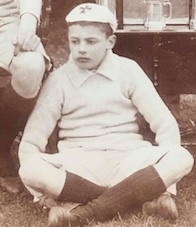Robert Tor Russell
Robert Tor Russell, CIE DSO (1888–1972) was a British architect.[1] In his position as Chief Architect to the Public Works Department, Government of India, he is primarily associated with the development of the city of New Delhi in the early 1930s. He designed some of the city's most notable buildings and was the architect of Connaught Place, the financial centre of the new capital. Russell also served with distinction during the First World War, and later, after retiring from India, became a civil servant for the British Government.
Robert Tor Russell | |
|---|---|
 | |
| Born | 1888 Hitchin, Hertfordshire, England |
| Died | 1972 Tiverton, Devon, England |
| Education | Bedford Modern School |
| Known for | Chief Architect to the Public Works Department, Government of India |
Early life
Robert Tor Russell was born in Hitchin, Hertfordshire in 1888 and was educated at Bedford Modern School.[2] In 1906 he became a pupil of his father, the architect S. B. Russell (1864–1955), and qualified to practice in 1913. In 1914 he was offered the position of assistant to John Begg, consulting architect to the Government of India.[3]
Career
Military Service
Russell's career in architecture was interrupted by the First World War. He served in Mesopotamia (Iraq) with the Artists Rifles and was Mentioned in Despatches and awarded the Distinguished Service Order for action during the British advance on Turkish-held Baghdad in the early months of 1917. His citation was as follows: 'For conspicuous gallantry and devotion to duty in charging the enemy's trench which was strongly held. He then led a bombing attack and cleared two-hundred yards of the trench. Later, he maintained his position for four hours, when reinforcements arrived'.[4]
New Delhi
In 1919 he returned to India and rose to become Chief Architect to the PWD. In this position he led the team that established the monumental architecture of New Delhi according to the neo-classical model envisaged by Sir Edwin Lutyens. His main creative period was between 1929 and 1933. During this period he designed Teen Murti Bhavan (Flagstaff House) originally for the Commander in Chief of the British Indian Army; it subsequently became the residence of Jawaharlal Nehru. The Eastern and Western Courts on Janpath (Queensway) built to accommodate Indian legislators were Russell's work, as were the bungalows numbers 1,3,5,7 Lok Kalyan Marg, which now comprise 7, Lok Kalyan Marg, the official residence of the Indian Prime Minister.[5][6]
Russell also designed Safdarjung Airport, National Stadium, Delhi, and several colonial mansions and government housing in the area which is known as Lutyens' Delhi[7] In 1931, he designed the round New Delhi General Post Office (Gole Dak Khana) building in the Gole Market locality. Situated inside a busy roundabout earlier known as Alexandra Place.[8] He also designed the Pataudi Palace for the Nawabs of Pataudi, in Haryana.[9][10] Russell's most obvious legacy is Connaught Place, two concentric circles of colonnaded streets modelled after the Georgian architecture of Royal Crescent in the English city of Bath, which became the commercial hub of the City.[7]
He was appointed CIE for his work on the development of New Delhi in 1930.[11]
Later life
Russell retired from India in 1941 and returned to Britain whereupon he took on the position as Chief Planning Inspector for the Ministry of Housing and Local Government until 1954. He had married Ethel Hatch in 1921 and they had one son and one daughter. He retired to Tiverton, Devon where he died in 1972.[12]
References
- Obituary in The Times, Mr Robert Tor Russell CIE, 8 November 1972, p.19
- The Eagle vol. xiii, no. 4 (March 1917), p. 64.
- Grove Art Online, http://oxfordindex.oup.com
- S. Stagholl Higham, 'Artists' Rifles: Regimental Roll of Honour and War Record', (London, 1922), p. 50
- "Architectural marvels for the new capital". Hindustan Times. 20 August 2011. Retrieved 16 December 2014.
- Aman Nath (1 October 2007). "Lutyens' Delhi". Outlook. Retrieved 16 December 2014.
- "On World Post Day, 'lady postman' recalls old days and ways ,". The Indian Express. 9 October 2008. Retrieved 28 June 2013.
- ["When in CP, think of Robert Tor Russell"], The Times of India, 27 August 2011.
- Anuradha Chaturvedi; Dharmendar Kanwar (2 August 2010). DK Eyewitness Travel Guide: Delhi, Agra and Jaipur. DK Publishing. pp. 238–. ISBN 978-0-7566-7418-2. Retrieved 5 September 2013.
- 'Who was Who, vol. VII, 1971–80' (London, 1981)
- Who was Who